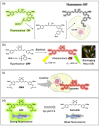Bioimaging and Sensing Properties of Curcumin and Derivatives
- PMID: 40430010
- PMCID: PMC12112241
- DOI: 10.3390/ijms26104871
Bioimaging and Sensing Properties of Curcumin and Derivatives
Abstract
Curcumin (Cur) is one of the most studied natural polyphenolic compounds, with many pharmacological properties and a luminescent skeleton. Natural fluorescent molecules are peculiar tools in nanomedicine for bioimaging and sensing, and this review focuses on the photophysical properties and applications of Cur in these biomedical fields. The first part of the review opens with a description of the Cur chemical skeleton and its connection with the luminescent nature of this molecule. The 1,6-heptadiene-3,5-dionyl chain causes the involvement of Cur in a keto-enol tautomerism, which influences its solvatochromism. The polyphenolic nature of its skeleton justifies the Cur generation of singlet oxygen and ROS upon photoexcitation, and this is responsible for the photophysical processes that may be related to the photodynamic therapy (PDT) effects of Cur. In the second part of the review, bioimaging based on Cur derivatives is reviewed, with a deeper attention paid to the molecular diagnostic and nano-formulations in which Cur is involved, either as a drug or a source of fluorescence. Theragnostics is an innovative idea in medicine based on the integration of diagnosis and therapy with nanotechnology. The combination of diagnostics and therapy provides optimal and targeted treatment of the disease from its early stages. Curcumin has been involved in a series of nano-formulations exploiting its pharmacological and photophysical characteristics and overcoming its strong lipophilicity using biocompatible nanomaterials. In the third part of the review, modifications of the Cur skeleton were employed to synthesize probes that change their color in response to specific stimuli as a consequence of the trapping of specific molecules. Finally, the methodologies of sensing biothiols, anions, and cations by Cur are described, and the common features of such luminescent probes reveal how each modification of the skeleton can deeply influence its natural luminescence.
Keywords: bioimaging; curcumin; luminescence; nano-formulation; sensing; theragnostics.
Conflict of interest statement
The authors declare no conflict of interest.
Figures












References
-
- Jyotirmayee B., Mahalik G. A review on selected pharmacological activities of Curcuma longa L. Int. J. Food Prop. 2022;25:1377–1398. doi: 10.1080/10942912.2022.2082464. - DOI
Publication types
MeSH terms
Substances
LinkOut - more resources
Full Text Sources

